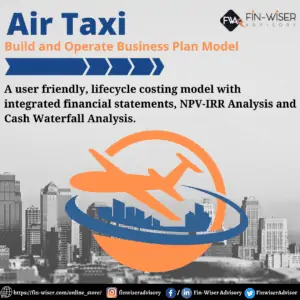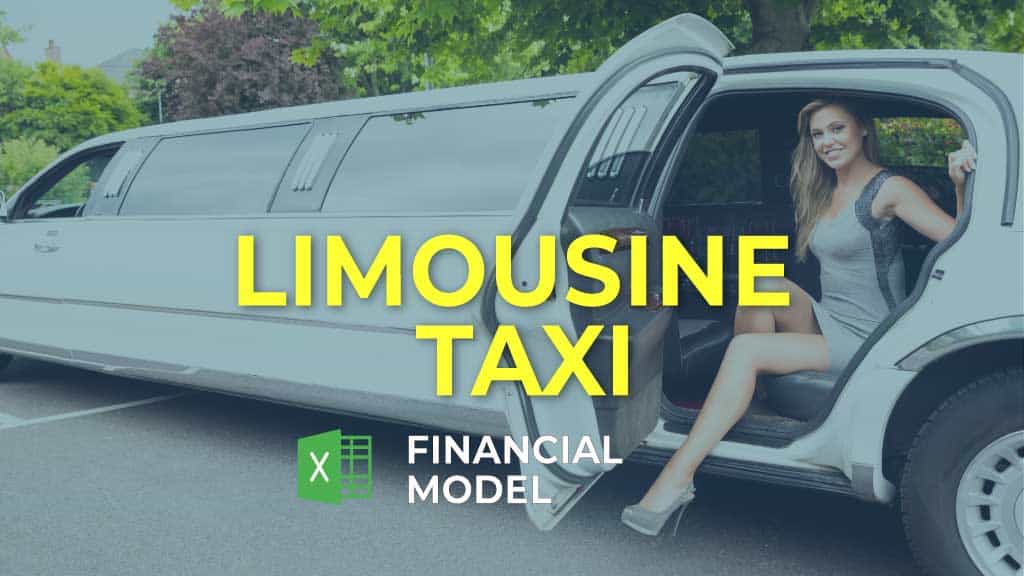Taxi Company Business Financial Model
Embark on the road to success by starting your own Taxi Company Business. This comprehensive 10-year monthly Excel financial model template offers an ideal basis in understanding and analyzing the expected profits and costs, and how much funding is needed to be raised from banks and other investors. The Excel template lays out a bottom-up calculation of the expected Taxi Company business revenues, costs, and profits. This includes a detailed forecast of the taxi fleet schedule, the average daily rides per Taxi, the average taxi fare per ride, and the expected cost structure from which the revenues and costs can be derived.

With a steady and evergreen demand for transportation services, a taxi company business offers a golden opportunity for entrepreneurs. Whether navigating the bustling city streets or providing a touch of luxury, the versatility of a taxi business lets you drive your way to success. The potential for growth, low entry barriers, and the chance to positively impact your community make this journey both exciting and rewarding.
How will this Taxi Company Financial Model help you start your business?
In starting a Taxi Company business, a financial Excel model can provide analysis for your business plan by answering the following key questions:
- How much is the required investment?
- What strategy is better – to buy or to lease the Taxis?
- What is the average daily ride per Taxi?
- How much is the average Taxi Fare per ride?
- How many taxi drivers are there per taxi?
- What are the anticipated operating Taxi Company business costs?
- What is the average ride per Taxi, or at what taxi fares can result in break-even?
- How will the monthly seasonality regarding taxi rides utilization and taxi fares affect the income of a Taxi Company Business?
- How much cash can this Taxi company business generate?
- What will the expected monthly and annual profits be?
- What is the Taxi fleet expansion schedule, and what are the Taxi financing requirements?
- How would the debt schedule look like when proposed to the bank for funding?
- What are the projected returns for Equity Shareholders when investing in this business?
In order to offer the Taxi company the best opportunity to become profitable, providing answers to questions like these will strengthen your business strategy and help you avoid numerous common challenges.
What drives the Profit Margin of the Taxi Company Business?
With this well-developed Taxi Company business financial model, entrepreneurs, business owners, and investors may obtain deep insights into the economics of their Taxi Company business models. Preparing a financial plan allows one to study the financial viability when starting a new Taxi Company business and better prepare for fundraising discussions with banks and investors. The model offers a combination of assumptions and business analysis to understand the driving forces of profitability and investor returns for a Taxi Company business.
- Taxi Fleet Size
- Taxi Types – up to five
- Average daily rides per Taxi type
- Average Taxi fare per ride
- Company Options which allow Upselling
- Cost Structure
- Impact of Seasonality on Utilization Rates and Fares
- Financing of Taxis, either purchasing or leasing
- Use of Bank Financing
All these factors affect the Taxi Company business profit margins, and studying how your intended business model will be affected by these factors is highly recommended. This allows for better planning and enhances your chance of success when starting a Taxi Company Business.
Understanding Taxi Fleet Expansion and Financing Scenarios
Business profitability and expansion are essential to long-term success in the dynamic world of Taxi company business. Expanding your Taxi fleet is a strategic move that requires careful consideration to identify how much capital is necessary for the expansion. This Taxi Company Excel template models the expansion of your Taxi fleet and the required replacements when Taxis reach a certain age to keep your fleet modern and up to date.
- Model up to 5 expansion steps of your Taxi fleet
- Choose when to lease and when to purchase the Taxis
- Input the expected Taxi usage period
- Model expected profits/losses from the sale of vehicles once they reach a certain age.
- Model the impact of changing the Taxi mix of your fleet over time.
- Take into account new Bank Loans every time you expand your Taxi fleet.
Expansion of your Taxi Company fleet should be carefully planned to steer your firm toward a bright future.
Modeling the Impact of Operation Drivers to Enhance Financial Performance
The spreadsheet is designed to help you understand how operational improvements will affect the financial performance of your Taxi Company business over time. This can be especially valuable when trying to figure out the upside potential of your business:
- Seasonality Index Rates: Experiment with different monthly utilization rates of daily rides per Taxi.
- Company Rates: Adjust Taxi fare rates to balance competitiveness and profitability. Use the seasonality adjustment factor to optimize your Taxi Company business income, setting different prices during low and high seasons.
- Taxi Usage Duration: Analyze how extending or shortening the average usage duration of Company Taxis affects your operational performance and cash flows.
- Manage Employees: Understand how many employees are needed monthly using seasonality index factors.
- And many more variables to play with.
Obtain a deep understanding of the expected Taxi Company business profit margins.
Taxi Company Business Model Structure
The Excel spreadsheet offers a bottom-up approach to planning the financial performance of your Taxi Company business model. The calculations will result in a financial forecast containing all the relevant metrics that banks and investors typically require.
Spreadsheet Structure
The worksheets inside this spreadsheet are structured as follows:
- Instructions and Terms of Abbreviations: Short briefing of the key concepts used in this template, terms and abbreviations, and how to work with this template.
- Assumptions Sheet
- Financial Calculations: Comprehensive 10-year monthly forecast aggregated into an annual sheet.
- Budget Analysis: Zoom in on any selected year to better understand the Monthly Forecast and Budget
- Executive and Detailed Summary: Contains tables and charts that illustrate the result of the projected financial plan and allow for deep analysis.
Main Features
The spreadsheet comes with the following main features:
- Taxi Fleet Schedule: The model includes a detailed Taxi fleet schedule, modeling the additions, disposals, and replacements of up to 5 Taxi types in your fleet. Identify the expected utilization period per Taxi type and the planned expansion steps.
- Taxi Fleet Ownership: The model foresees that the Taxis either (1) will be purchased (CAPEX), activated on the Balance Sheet, and depreciated, or (2) will be leased (leading to monthly costs included in OPEX).
- Taxi Resale at the End of the Planned Utilization: The model assumes that the purchased Taxis are only utilized during the specified period and are sold afterward. The sale of the old Taxis results in Gains/Losses from old Taxi Disposals. These gains/losses are calculated depending on the difference between the assumed resale price and the approximate book value at the time of sale.
- Revenue Model: The model foresees revenues from the average daily rides per Taxi, gains from the disposal of Taxis, and other income.
- Taxi Fare income: This is estimated by the number of Taxis in operation, the average number of rides per Taxi, and the taxi fare rate per ride. The utilization of taxi rides and average taxi fares can be adjusted monthly to reflect the business’ seasonality.
- Land and Building: The model foresees that you can own/rent a property, which is also valued separately at exit, to maximize the value of your business.
- Cost Assumptions and Schedules are available for Capital Expenditures (CAPEX), direct and variable costs, employee costs, and Operating Expenses (OPEX).
- Detailed Monthly and Yearly Financial Statement Projections: The spreadsheet is designed logically, outlining the calculations of Taxi Company business revenues and costs, which adds to the transparency and understanding of the model. This then results in forecasted financial statement projections – Income Statement, Balance Sheet, Cash Flow Statement, and Financial Ratios together with a series of tables and breakdowns to understand the drivers and composition of profitability.
- Forecasted Business Valuation: The valuation is divided into Business and Property values. This approach enables investors to optimize their exit value through potential sale and leaseback scenarios at exit.
- Free Cash Flow Projections: Unlevered and levered cash flow projections are provided. The differentiation in levered/unlevered allows us to understand how much debt financing affects the expected project and investor returns.
- Funding Amount, Uses and Sources of Funds and Financial Metrics: The model calculates the required financing amount to execute your business plan, provides a suggested breakdown of uses and sources of funds and the resulting financial metrics of your business plan: Internal Rate of Return, Cash on Cash Yield, Payback Period, Net Present Value (NPV).
- Summaries, Charts, Schedules: The financial plan is summarized in a condensed Executive Summary, a Detailed Summary containing more breakdowns, charts, and tables, and a Budget Analysis sheet, which focuses on understanding the budget for a select forecast year.
Overall, this Excel model analysis tool was developed to obtain a solid understanding of how the assumptions will impact the economic performance of the business and allow for modeling countless financial scenarios. Improve your financial decision-making today by using this Taxi Company spreadsheet template.
Embark on a Promising Venture by starting your Taxi Company Business
This financial model template comes pre-filled with an example forecast of a Taxi Company business to illustrate clearly how the spreadsheet works. The forecast can be easily changed by altering the assumptions in blue and light blue font color. Using a solid financial model, investors may successfully manage risks, attract stakeholders, and assess the long-term profitability of their Taxi Company Business.
Obtain your copy today to start making informed decisions based on data. The fully editable Excel model is currently at Version 1.5. A free downloadable PDF demo version is available to help you understand the model structure.
File Types:
.xlsx (MS Excel)
.pdf (Adobe Acrobat Reader)
Similar Products
Other customers were also interested in...
Car Rental Business Financial Model
This Car Rental Business Financial Model Template in Excel offers an ideal basis for developing a bu... Read more
Crane Rental Company Financial Model
Dive into the financial planning of your Crane Rental Company with our comprehensive 10-year monthly... Read more
Air Taxi – Build and Operate Business Plan Model...
The flying taxi market is ready for takeoff, changing the travel experience forever. Fin-wiser’s A... Read more
Online Car Rental – 3 Statement Financial Mo...
Online Car Rental Platform Business Plan Model is a perfect tool for a feasibility study on launchin... Read more
Car Rental Financial Model Excel Template
Order Car Rental Pro-forma Template. Simple-to-use yet very sophisticated planning tool. Get reliabl... Read more
Limousine Taxi Financial Model Excel Template
Order Limousine Taxi Pro Forma Projection. Impress bankers and investors with a proven, strategic bu... Read more
Concierge Service Financial Model Excel Template
Impress bankers and investors with a proven, solid Concierge Service Pro Forma Projection. Highly ve... Read more
Helicopter Taxi Financial Model Excel Template
Helicopter Taxi Budget Template Impress bankers and investors with a proven, strategic business plan... Read more
Motorboat Rental Business Financial Model
Dive into the heart of financial planning with our Motorboat Rental Business Financial Model, design... Read more
Kayak Boat Rental Business Model
Dive into the future of your kayak boat rental business with our cutting-edge 10-year monthly financ... Read more
You must log in to submit a review.



























